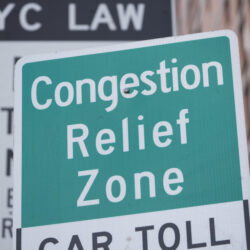
✰PREMIUM
Spotlight: How are yellow taxis doing in 2025?
Part one: A tough road

Watch a movie about New York City, and you’ll see them. Scan a postcard or examine a painting or read a book depicting this city, and you’ll find them. Yellow taxis stand as a symbol for the city of New York.
New York City’s yellow taxis are about as old as the Empire State Building. The city first began issuing taxi medallions in 1937 — small tin permits that allow a taxi driver to operate in New York City. These medallions, smaller than a playing card, created an industry that largely remained a pathway to the middle class for the next 80 years, and then nearly destroyed it.
The medallion crisis
Taxi medallions were once considered a gateway to economic stability. Fueled by the city’s aggressive marketing of medallions as foolproof investments, the value of a medallion began to climb dramatically in the early 2000s. According to a class action lawsuit brought forward by taxi drivers in 2021, the Taxi and Limousine Commission and city officials preyed on the dreams and ambitions of a largely immigrant workforce by promising hopeful cabbies that a medallion would secure them a steady, permanent source of income.
The suit claims that these city auctioneers deliberately lied in order to artificially inflate the medallion’s value. By 2014, a medallion was going for over a million dollars. Predatory lenders issued high-interest loans worth hundreds of thousands of dollars to cabbies while disregarding the borrowers’ ability to repay.
The city, which relied on medallion sales as a source of revenue, failed to regulate these practices. The result: thousands of cabbies were locked into crushing debt structures.
In 2014, the bubble burst. Uber and Lyft entered the market, decimating taxi revenue and, consequently, medallion value. Between 2013 and 2016, the value of an NYC yellow taxi medallion fell more than 30%, from just over $1 million to around $600,000. In the same time period, from January 2013 to January 2016, total taxi rides fell about 26%, down from 13 million to 9.6 million.
By January 2019 that number was 6.7 million, and the value of medallions had plummeted to a fraction of their peak price. Drivers were left completely bereft, their sole asset now worth far less than the sum they owed.
The lenders, who had extracted hundreds of millions of dollars during the surge in medallion prices, avoided significant consequences. Many of these lenders, including private equity firms and specialized financial institutions, continued to make money after the collapse through aggressive debt collection efforts that forced hundreds of drivers into bankruptcy or foreclosure.
“I don’t think I could concoct a more predatory scheme if I tried,” said Roger Bertling, the senior instructor at Harvard Law School’s Predatory Lending and Consumer Protection Clinic. “This was modern-day indentured servitude.”
In 2018, six professional cab drivers committed suicide. “When I hear that somebody did suicide, I was thinking about me,” Mr. Singh, a taxi driver for three decades, told the New York Times in 2018. “I’m going to be one of them one day.”
A post-pandemic revival
After the collapse of medallions, the pandemic nearly wiped out NYC taxis. In January 2020, two months before the Covid-19 pandemic, cabbies recorded just over 6.3 million taxi rides. By April 2020, that number dropped to 230,000. There was a mass exodus of medallioned taxi drivers. Total drivership fell from 76,000 cabbies in March 2020 to just 22,000 in April 2020.
Through it all, the New York Taxi Workers Alliance (NYTWA), a labor organization established in 1998 that advocates for the rights and welfare of New York City taxi drivers, worked tirelessly to raise awareness about the crisis.
From 2018-2019, NYTWA held a series of public vigils in honor of those who had died and hosted large demonstrations in front of City Hall, calling on the city to take responsibility for inflating medallion prices and to provide financial relief for drivers. In October and November 2021, NYTWA organized a two-week hunger strike outside City Hall until officials achieved a debt relief program, drawing immense media attention and public support.
Their efforts succeeded. In November 2021, the city and Marblegate Asset Management, the largest distributor of medallion loans, agreed to cap medallion debt at $170,000 (many drivers owed over $500,000), and reduce monthly payments to $1,122. The city also agreed to back the loans, providing guarantees to lenders.
NYTWA continued its advocacy efforts, leading to an expansion of the original initiative in 2022. The Medallion Relief Program Plus (MRP+) further extended debt forgiveness and financial support to drivers who had previously been overlooked. “Our taxicab medallion owners and drivers have always kept New York City moving, and it is finally time we pay it forward with real debt relief for owners in need,” Mayor Eric Adams said in an August 2022 news release. “We are likely putting tens of thousands of dollars back into the pockets of these owner-drivers.”
The plan brought relief to approximately 3,000 cab drivers, who owed over $500,000 in debt on average.
Taxi drivers continued to earn victories in the years following MRP+. In 2022, Uber announced a deal to integrate yellow taxis into its app, transforming former adversaries into collaborators. This partnership allowed taxi drivers to tap into Uber’s expansive customer base, which meant a more consistent stream of ride requests, and a way to stay competitive in an era dominated by app-based ride-hailing.
Although taxi drivers have largely recovered from the despair of the medallion crisis, they continue to face new challenges year by year. Come back tomorrow for part two of this article, in which we explore what 2025 has in store for our taxi drivers.
Leave a Comment
Related Articles


After NY ignores latest deadline, feds give yet another month to stop congestion pricing

3-car crash injures 3, takes out awning, in Brooklyn Heights




